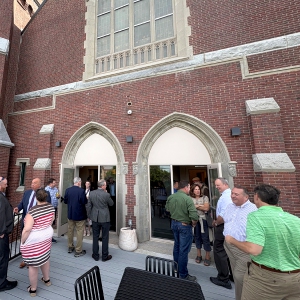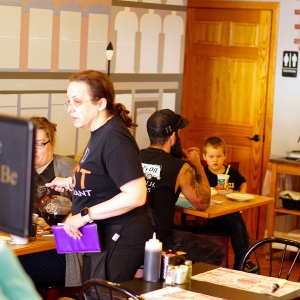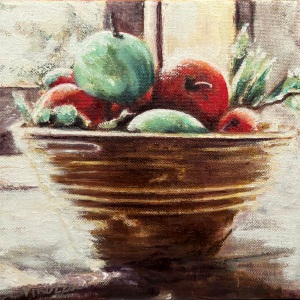Hay feeders can be cow traps
| Published: 02-09-2019 8:25 PM |
Topper’s horns were wedged tight in the metal hay feeder. While reaching for a tasty bit of hay, he pushed his head into the feeder and turned his horns just so. Like a Chinese finger trap, the feeder wouldn’t let him back up. But he didn’t panic; he managed to keep munching the hay.
Hay feeders are metal contraptions designed to give livestock access to hay with minimal waste. In winter, we feed our cattle damp, fermented hay that looks like giant marshmallows. Cattle love to eat hay from a newly opened bale. They will grab the feed in their mouths and yank it to the ground. Sometimes a steer will attack the bale, tearing at it with his horns, before settling down to eat. But once that hay gets muddy or trampled they’ll walk away, just as you might turn your nose up at week-old leftovers.
Different hay feeders use different designs to keep hay off the ground, encouraging picky cows to eat every last morsel. Miles Smith Farm has three different models. The one that captured Topper is a square hopper with metal bars in the middle to hold back the hay. One 1,000-pound bale fits into the center hopper. Bars are set so that cows can reach through to pull out hay. A metal tray around the base catches stray hunks of hay, keeping them off the ground.
Being stuck in a feeder is more than unpleasant; it can be deadly. When other cattle detect that one of the herd is in trouble, they might attack the defenseless cow. It is unlovely behavior, and I try not to think about it, but there it is. Maybe the helpless cow has offended them, and now it’s time for revenge. Who knows?
Years ago, that happened to one of our steers. I found him, horns wedged in the feeder, murdered by his peers. Imagine my disappointment in the herd. Another time a steer’s hoof was sandwiched between a wheel and the frame of a mobile feeder. We were able to extract him, but his leg was broken.
Besides the danger, feeders also fail when hay is frozen solid. Since the cattle can’t break it up with their horns, a human (husband Bruce or I) must climb into the feeder and claw at icy hay, trying to peel it apart. In some cases, we’ve fired up the Bobcat, our mechanical workhorse, and used its grabbers to break up the frozen lump.
Another downside of a feeder is the mire that builds up around it. Where cattle congregate, so does manure. When the ground thaws, the area around a feeder will turn into slime. Yes, feeders can be moved, but sometimes in deep snow that’s not so easy.
We’ve sold all but three of our feeders. We’ve been using them less and less; we usually just open a bale and put the hay on the ground. A herd of 15 to 20 cattle will eat an entire 1,000-pound round bale in 24 hours. Because they gobble it up so fast, typically there is no waste. The quagmire problem is solved because we can place the hay anywhere we want in a field – picking a new spot every day. This serves to distribute the cow manure and more evenly fertilize the fields.
Article continues after...
Yesterday's Most Read Articles
 New Concord apartments open in former First Congregational Church
New Concord apartments open in former First Congregational Church
 Inside EFAs: How school vouchers have fueled an enrollment boom at Christian schools across New Hampshire
Inside EFAs: How school vouchers have fueled an enrollment boom at Christian schools across New Hampshire
 St. Paul’s School won’t reopen public access to Turkey Pond
St. Paul’s School won’t reopen public access to Turkey Pond
 ‘Bittersweet’: The Post on Main Street closes Friday
‘Bittersweet’: The Post on Main Street closes Friday
 Goodwell Foods takes over Rustic Crust private label frozen pizza
Goodwell Foods takes over Rustic Crust private label frozen pizza
 Messy parking around Concord’s bus terminal won’t get less messy any time soon
Messy parking around Concord’s bus terminal won’t get less messy any time soon
And if there is any waste, it’s put to use. Tired cattle lie on it; it insulates them from snow and the frozen ground. In the spring that old hay will disintegrate and create fertilizer for the grass.
Try as we might, we could not maneuver Topper’s horns to extract his head. It was like trying to solve one of those nail puzzles. So we cheated – Bruce got out the Sawzall and cut through one of the metal bars. Then my friend Melissa and I were able to pull the bar just enough to allow Topper to free himself. Unfazed, he ambled off looking for his friends.
That did it; we’ve retired our feeders for the winter. For now, the cows don’t mind eating from the ground, breaking up the frozen bales with their horns, and I don’t miss climbing into a feeder to break up frozen hay with numb fingers.
The end of this negative report might be an ineffective place to ask, but does anyone want to buy a used feeder with a bent bar? Sold “as-is.”
(Carole Soule is co-owner of Miles Smith Farm, where she raises and sells pastured pork, lamb, eggs and grassfed beef. She can be reached at cas@milessmithfarm.com.)
]]>







 Vintage Views: The Liars Club
Vintage Views: The Liars Club Two Villages Art Society begins summer members show
Two Villages Art Society begins summer members show Artist Spotlight: Brittany Batchelder
Artist Spotlight: Brittany Batchelder Young Professional of the Month Katie Duncan shares about creativity, community, connection
Young Professional of the Month Katie Duncan shares about creativity, community, connection
